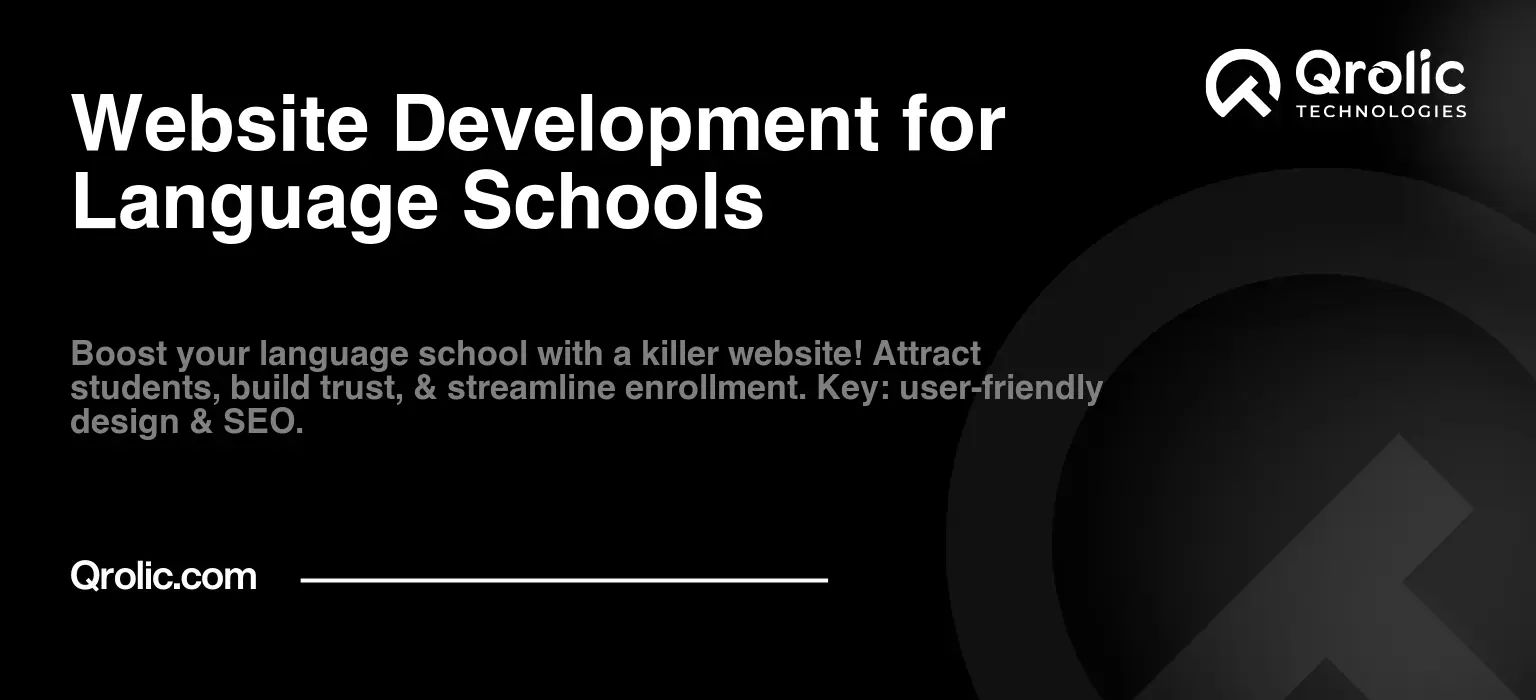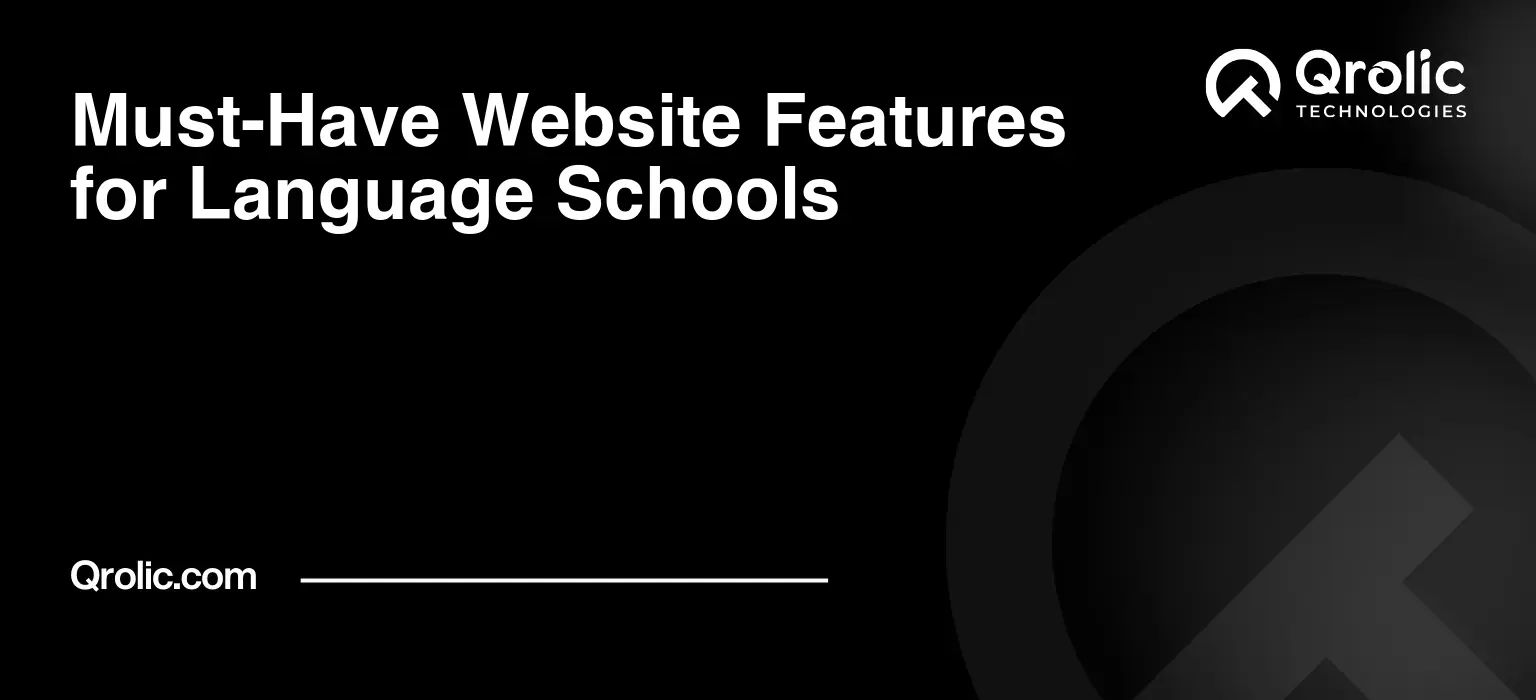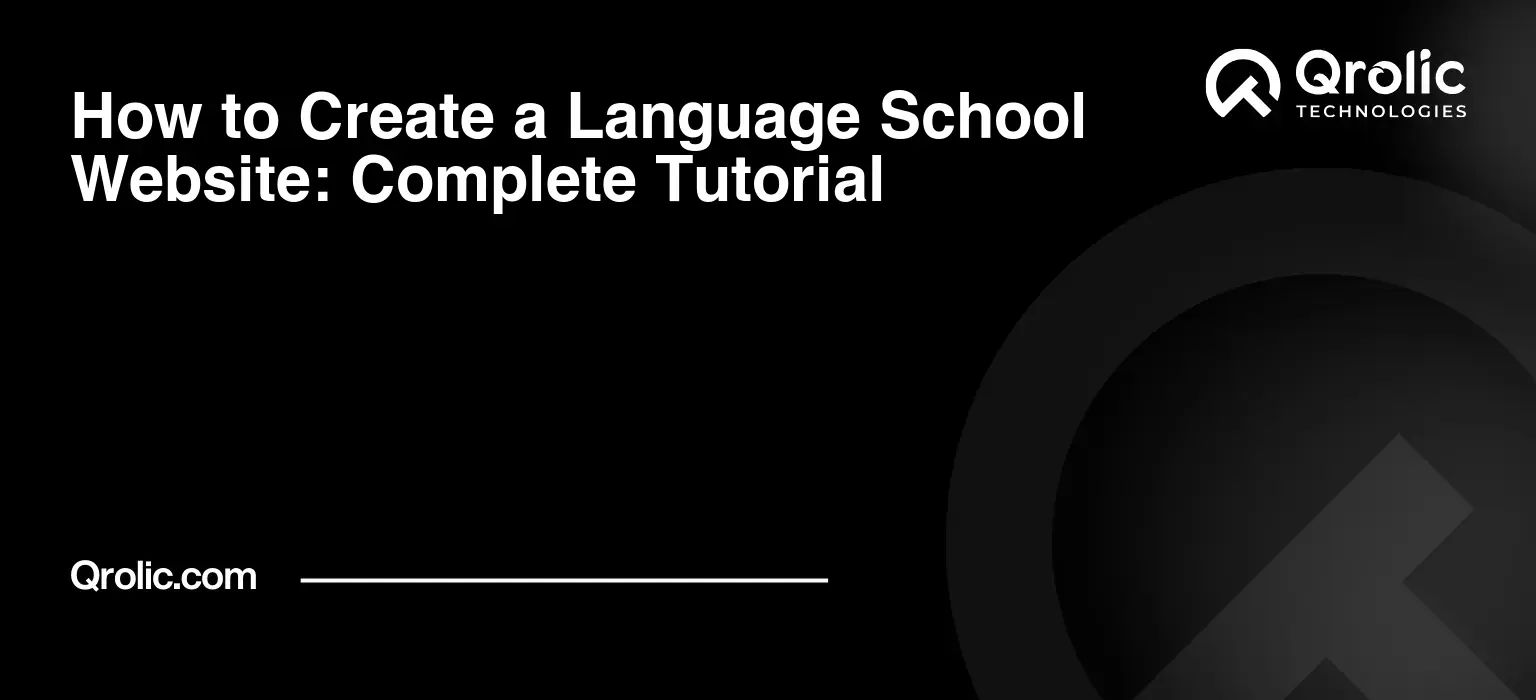Quick Summary:
- Your website is key to attract students and build trust.
- Ensure easy navigation, mobile view, and clear course details.
- Optimize with SEO so students can find you online.
- Avoid common errors; professional help ensures success.
Table of Contents
- Why Your Language School Needs a Killer Website
- The Ever-Increasing Digital Student Population
- Building Trust and Credibility (Education Web Design)
- Showcasing Your Unique Programs and Offerings
- Providing Essential Information and Answering Key Questions
- Streamlining the Enrollment Process (Language Learning Website Design)
- Global Reach and Accessibility
- Cost-Effective Marketing
- Key Features of a High-Converting Language School Website
- User-Friendly Navigation
- Mobile Responsiveness
- Compelling Visual Design
- Course Catalog with Detailed Information
- Online Enrollment Form
- Secure Payment Gateway
- Blog and Resources
- Testimonials and Social Proof
- Contact Information and Location
- Multi-Language Support
- Integration with Social Media
- SEO Strategies for Language School Websites
- Keyword Research: Understanding Your Target Audience’s Search Terms
- On-Page Optimization: Making Your Website Search Engine Friendly
- Off-Page Optimization: Building Authority and Backlinks
- Local SEO: Targeting Students in Your Area
- Common Mistakes to Avoid in Language School Website Development
- Ignoring Mobile Responsiveness
- Poor Navigation and Site Structure
- Lack of Clear Call-to-Actions (CTAs)
- Overloading with Too Much Information
- Neglecting Website Security
- Ignoring SEO Best Practices
- Using Low-Quality Images and Videos
- Not Tracking Website Analytics
- Forgetting Website Accessibility
- Steps to Take When Creating a Language School Website
- Benefits of Professional Website Development for Language Schools
- Expertise and Experience
- Custom Design and Development
- SEO Optimization
- Technical Support and Maintenance
- Improved User Experience
- Scalability
- Qrolic Technologies: Your Partner in Education Web Design
- Conclusion
Why Your Language School Needs a Killer Website
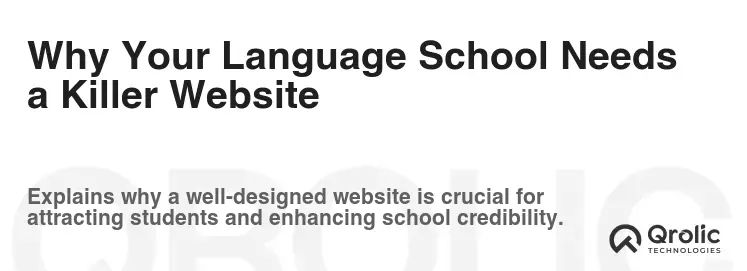
In today’s digital age, a robust online presence is non-negotiable for any business, and language schools are no exception. Think of your website as your 24/7 global ambassador, constantly working to attract new students, build credibility, and showcase your unique offerings. But just any website won’t cut it. You need a killer website – one that’s visually appealing, user-friendly, and optimized to convert visitors into paying students. Why? Let’s break it down.
The Ever-Increasing Digital Student Population
The number of students searching for language courses online is constantly growing. These students are your potential customers, actively seeking the services you provide. If your website isn’t easily found or doesn’t make a strong first impression, you’re losing out on a significant portion of your target audience. They’re finding your competitors instead.
Building Trust and Credibility (Education Web Design)
A professional website instantly boosts your school’s credibility. It shows potential students that you’re serious about education and invested in providing a high-quality learning experience. Think of it as your online storefront. A well-designed and informative website projects an image of professionalism and competence, vital for attracting students and their parents. It shows you’re a legitimate, trustworthy institution worth investing in.
Showcasing Your Unique Programs and Offerings
Your website is the perfect platform to highlight what makes your language school special. Do you offer specialized courses, experienced instructors, or a unique teaching methodology? Use your website to showcase these advantages and differentiate yourself from the competition. High-quality images and videos of your classrooms, instructors, and student activities can bring your school to life and create a more engaging experience for visitors. Detail the curriculum, learning outcomes, and any unique aspects of each course.
Providing Essential Information and Answering Key Questions
Potential students have questions. Lots of them. Your website should provide clear and concise answers to common inquiries about course schedules, pricing, enrollment procedures, and school policies. A comprehensive FAQ section can save you time and effort by addressing frequently asked questions upfront. Easy access to this information builds trust and reduces friction in the enrollment process.
Streamlining the Enrollment Process (Language Learning Website Design)
A well-designed website can streamline the entire enrollment process, making it easier for students to sign up for courses. Online application forms, secure payment gateways, and automated confirmation emails can significantly reduce administrative overhead and improve the student experience. A smooth and efficient enrollment process reflects positively on your school and encourages more students to join.
Global Reach and Accessibility
Unlike a physical school, your website is accessible to anyone, anywhere in the world. This allows you to reach a global audience of potential students who may not have otherwise considered your school. By offering language courses online or blended learning options, you can further expand your reach and cater to a diverse student population.
Cost-Effective Marketing
Compared to traditional marketing methods like print advertising or radio commercials, a website is a relatively cost-effective way to promote your language school. With proper SEO and content marketing strategies, you can attract a steady stream of qualified leads to your website without breaking the bank. Your website is the central hub of your digital marketing efforts, working 24/7 to generate leads and drive enrollment.
Key Features of a High-Converting Language School Website
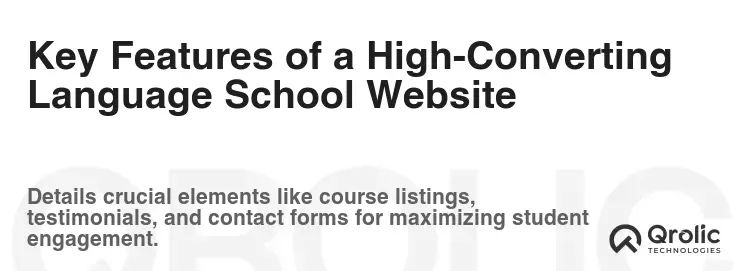
So, what exactly makes a website “killer” for a language school? It’s more than just having pretty pictures. It’s about creating a user-friendly, informative, and engaging experience that converts visitors into students. Here are some key features to consider:
User-Friendly Navigation
A website with confusing navigation will quickly frustrate visitors and drive them away. Your website should be easy to navigate, with clear and intuitive menus and links. Visitors should be able to find the information they need quickly and easily. A well-organized site structure and logical flow of information are essential for a positive user experience.
Mobile Responsiveness
More and more people are browsing the web on their mobile devices. Your website must be mobile-responsive, meaning it adapts seamlessly to different screen sizes and devices. A mobile-friendly website provides a better user experience for mobile users and is also a ranking factor in Google’s search algorithm.
Compelling Visual Design
Visual appeal is crucial for attracting and retaining visitors. Use high-quality images and videos that showcase your school, instructors, and students. A clean and modern design aesthetic can create a professional and trustworthy image. Pay attention to color schemes, typography, and overall layout to create a visually engaging experience.
Course Catalog with Detailed Information
Your course catalog should be easy to browse and provide detailed information about each course, including:
- Course Level: Clearly indicate the proficiency level of the course (e.g., Beginner, Intermediate, Advanced).
- Course Description: Provide a concise and engaging overview of the course content and learning objectives.
- Learning Outcomes: Clearly state what students will be able to do upon completion of the course.
- Course Schedule: Display the dates, times, and duration of each class session.
- Instructor Information: Introduce the instructors with brief biographies and qualifications.
- Pricing: Clearly state the course fees and any additional costs (e.g., textbooks, materials).
- Prerequisites: Specify any prior knowledge or skills required for the course.
- Student Testimonials: Include positive reviews from past students to build trust and credibility.
Online Enrollment Form
Make it easy for students to sign up for courses directly through your website. An online enrollment form should be simple, secure, and user-friendly. Collect only the necessary information and provide clear instructions for each step of the process. Offer various payment options and automated confirmation emails.
Secure Payment Gateway
If you’re accepting payments online, it’s essential to use a secure payment gateway to protect your students’ financial information. Choose a reputable payment processor that offers encryption and fraud prevention features. Display security badges and certifications to reassure students that their transactions are safe.
Blog and Resources
A blog is a great way to attract new visitors to your website and establish your school as a thought leader in the language learning industry. Share informative articles, tips, and resources related to language learning, cultural immersion, and travel. This content can help you attract targeted traffic from search engines and social media.
Testimonials and Social Proof
Positive testimonials from satisfied students are a powerful form of social proof. Feature these testimonials prominently on your website to build trust and credibility. Encourage students to leave reviews on your website and on third-party review sites like Google My Business.
Contact Information and Location
Make it easy for potential students to contact you by providing clear and accessible contact information, including your phone number, email address, and physical address. Include a map on your contact page to help visitors find your school.
Multi-Language Support
If you cater to students from different countries, consider offering your website in multiple languages. This can significantly improve the user experience for international students and increase your global reach.
Integration with Social Media
Integrate your website with your social media channels to make it easy for visitors to connect with you online. Display social media icons on your website and encourage visitors to follow you on social media. Use social sharing buttons to make it easy for visitors to share your content with their networks.
SEO Strategies for Language School Websites
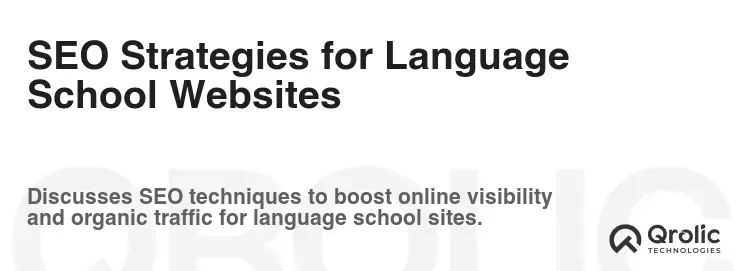
Having a beautiful website is only half the battle. You also need to make sure that potential students can find your website on search engines like Google. This is where Search Engine Optimization (SEO) comes in.
Keyword Research: Understanding Your Target Audience’s Search Terms
The first step in any SEO strategy is keyword research. This involves identifying the keywords and phrases that potential students are using to search for language courses online. Use keyword research tools like Google Keyword Planner, Ahrefs, or SEMrush to find relevant keywords with high search volume and low competition. Consider keywords related to:
- Specific Languages: “Spanish classes,” “French lessons,” “Mandarin courses.”
- Location: “English courses in [City],” “German school near me.”
- Course Type: “Online Spanish classes,” “Intensive English courses,” “Business French.”
- Target Audience: “Spanish classes for kids,” “English courses for adults,” “TOEFL preparation courses.”
On-Page Optimization: Making Your Website Search Engine Friendly
Once you’ve identified your target keywords, you need to optimize your website to rank for those keywords. This involves optimizing various on-page elements, including:
- Title Tags: The title tag is the most important on-page SEO element. It’s the title that appears in search engine results pages (SERPs) and in the browser tab. Each page on your website should have a unique and descriptive title tag that includes your target keywords.
- Meta Descriptions: The meta description is a brief summary of the page content that appears below the title tag in the SERPs. Write compelling meta descriptions that entice users to click on your website.
- Header Tags (H1-H6): Use header tags to structure your content and make it easier to read. The H1 tag should be used for the main heading of the page and should include your primary keyword. Use H2-H6 tags for subheadings and to break up your content into logical sections.
- Content Optimization: Create high-quality, informative, and engaging content that is relevant to your target keywords. Use your keywords naturally throughout the content, but avoid keyword stuffing. Focus on providing value to your readers and answering their questions.
- Image Optimization: Optimize your images by using descriptive file names and alt tags. Alt tags are used to describe the image to search engines and screen readers. They should include your target keywords and provide context for the image.
- URL Structure: Use clear and descriptive URLs that include your target keywords. Avoid using long and complicated URLs with unnecessary characters.
Off-Page Optimization: Building Authority and Backlinks
Off-page optimization involves building authority and credibility for your website through various external factors, such as:
- Backlink Building: Backlinks are links from other websites to your website. They are a strong signal to search engines that your website is authoritative and trustworthy. Earn backlinks from reputable websites in your industry, such as educational institutions, language learning blogs, and travel websites.
- Social Media Marketing: Social media marketing can help you build brand awareness, drive traffic to your website, and generate leads. Share your blog posts, course information, and other relevant content on social media to reach a wider audience.
- Online Directory Listings: List your language school in online directories like Yelp, Google My Business, and niche directories related to education and language learning.
- Guest Blogging: Write guest posts for other websites in your industry and include a link back to your website in your author bio.
Local SEO: Targeting Students in Your Area
If you have a physical language school, it’s important to optimize your website for local search. This involves:
- Google My Business Listing: Claim and optimize your Google My Business listing with accurate information about your school, including your address, phone number, website, and business hours.
- Local Citations: Build citations by listing your school in online directories and business listings.
- Local Keyword Targeting: Use local keywords in your website content and meta tags, such as “English courses in [City]” or “Spanish school near me.”
- Encourage Reviews: Encourage satisfied students to leave reviews on your Google My Business listing and other review sites.
Common Mistakes to Avoid in Language School Website Development
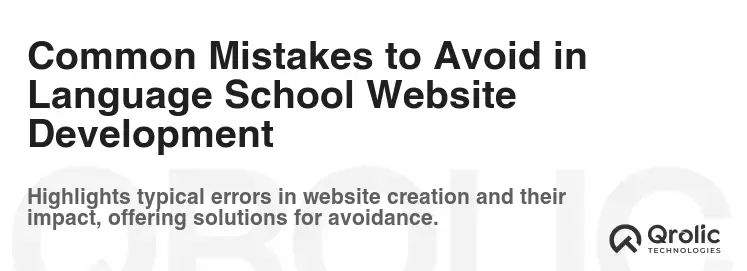
Developing a website for your language school can be a complex process. Here are some common mistakes to avoid to ensure your website is effective and successful:
Ignoring Mobile Responsiveness
As mentioned earlier, mobile responsiveness is crucial. Failing to optimize your website for mobile devices will result in a poor user experience for a significant portion of your audience and negatively impact your search engine rankings.
Poor Navigation and Site Structure
A confusing or poorly organized website will frustrate visitors and make it difficult for them to find the information they need. Invest in a clear and intuitive navigation system that makes it easy for users to explore your website.
Lack of Clear Call-to-Actions (CTAs)
Your website should have clear and compelling CTAs that guide visitors towards desired actions, such as signing up for a course, requesting more information, or contacting your school. Use action-oriented language and visually prominent buttons to make your CTAs stand out.
Overloading with Too Much Information
While it’s important to provide detailed information about your school and courses, avoid overwhelming visitors with too much text and complicated jargon. Keep your content concise, easy to read, and focused on the most important information.
Neglecting Website Security
Website security is paramount to protect your students’ data and maintain their trust. Ensure your website has an SSL certificate (HTTPS) and implement appropriate security measures to prevent hacking and data breaches.
Ignoring SEO Best Practices
Failing to optimize your website for search engines will make it difficult for potential students to find you online. Implement a comprehensive SEO strategy that includes keyword research, on-page optimization, and off-page optimization.
Using Low-Quality Images and Videos
Visuals play a crucial role in attracting and engaging visitors. Avoid using blurry, pixelated, or generic stock photos. Invest in high-quality images and videos that showcase your school, instructors, and students.
Not Tracking Website Analytics
Without tracking website analytics, you won’t be able to measure the effectiveness of your website and identify areas for improvement. Use tools like Google Analytics to track key metrics like website traffic, bounce rate, conversion rate, and keyword rankings.
Forgetting Website Accessibility
Ensure your website is accessible to people with disabilities by following accessibility guidelines like WCAG (Web Content Accessibility Guidelines). This includes providing alternative text for images, using sufficient color contrast, and making your website navigable using a keyboard.
Steps to Take When Creating a Language School Website
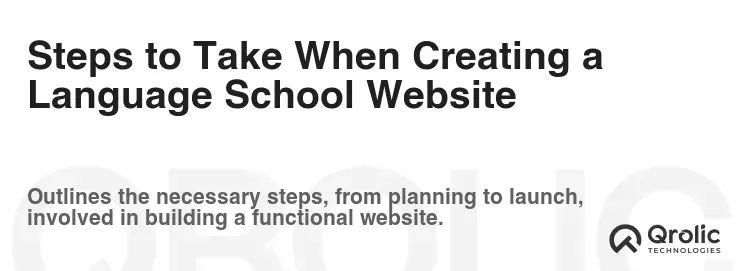
Creating a language school website involves several key steps to ensure it effectively meets your goals and serves your target audience. Here’s a breakdown of those steps:
1. Define Your Goals and Target Audience
- What are your primary goals for the website? (e.g., Generate leads, increase enrollment, provide information, build brand awareness).
- Who is your target audience? (e.g., Age, nationality, language level, learning goals). Understanding your target audience is crucial for tailoring your website’s content, design, and marketing efforts.
2. Choose a Domain Name and Hosting Provider
- Domain Name: Select a domain name that is relevant to your school, easy to remember, and reflects your brand.
- Hosting Provider: Choose a reliable hosting provider that offers sufficient storage, bandwidth, and security for your website. Consider factors like uptime guarantee, customer support, and scalability.
3. Select a Website Platform (CMS)
- Content Management System (CMS): Choose a CMS that is user-friendly, customizable, and offers the features you need. Popular options include:
- wordpress: A versatile and widely used CMS with a vast library of themes and plugins.
- Joomla: A powerful and flexible CMS suitable for complex websites.
- Drupal: A highly customizable CMS favored for its security and scalability.
4. Choose a Theme or Template
- Theme: Select a theme or template that is visually appealing, mobile-responsive, and aligned with your brand identity. Ensure the theme is compatible with your chosen CMS and offers the features you need.
5. Plan Your Website Structure and Content
- Sitemap: Create a sitemap to outline the structure and navigation of your website.
- Content Creation: Develop high-quality content for each page of your website, including:
- Homepage: An overview of your school, its mission, and key offerings.
- About Us: Information about your school’s history, instructors, and philosophy.
- Courses: Detailed descriptions of each course, including learning objectives, schedule, and pricing.
- Testimonials: Positive reviews from satisfied students.
- Blog: Articles and resources related to language learning and cultural immersion.
- Contact Us: Contact information and a contact form for inquiries.
6. Design and Develop Your Website
- Website Design: Design the visual elements of your website, including the layout, color scheme, typography, and imagery.
- Website Development: Implement the design using HTML, CSS, and JavaScript. Ensure the website is mobile-responsive, accessible, and optimized for search engines.
7. Integrate Essential Features and Plugins
- Plugins: Install and configure essential plugins, such as:
- SEO Plugin: To optimize your website for search engines (e.g., Yoast SEO, Rank Math).
- Contact Form Plugin: To create and manage contact forms.
- Security Plugin: To protect your website from hacking and malware.
- Analytics Plugin: To track website traffic and user behavior (e.g., Google Analytics).
8. Test and Refine Your Website
- Testing: Thoroughly test your website on different devices and browsers to ensure it functions correctly.
- Refinement: Make any necessary adjustments to the design, content, or functionality based on your testing results.
9. Launch Your Website
- Launch: Once you’re satisfied with your website, launch it to the public.
- Promotion: Promote your website through various marketing channels, such as social media, email marketing, and online advertising.
10. Maintain and Update Your Website
- Maintenance: Regularly maintain and update your website to ensure it remains secure, functional, and relevant.
- Content Updates: Add new content to your blog, update course information, and refresh the design as needed.
- SEO Monitoring: Continuously monitor your website’s SEO performance and make adjustments to your strategy as needed.
Benefits of Professional Website Development for Language Schools
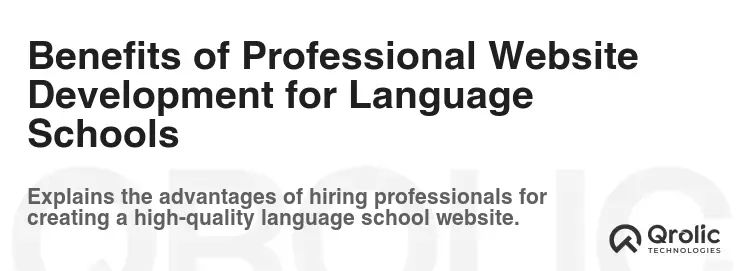
While it might be tempting to build your own website using a DIY website builder, there are significant benefits to hiring a professional website development agency.
Expertise and Experience
Professional web developers have the expertise and experience to create a website that is not only visually appealing but also functional, user-friendly, and optimized for search engines. They understand the latest Web Development trends and best practices and can ensure that your website is built to the highest standards.
Custom Design and Development
A professional web development agency can create a custom website design that is tailored to your specific needs and brand identity. This allows you to stand out from the competition and create a unique online presence.
SEO Optimization
Professional web developers understand the importance of SEO and can build your website with SEO best practices in mind. They can also help you develop an ongoing SEO strategy to improve your search engine rankings and attract more organic traffic to your website.
Technical Support and Maintenance
A professional web development agency can provide ongoing technical support and maintenance to ensure that your website remains secure, functional, and up-to-date. This can save you time and effort and give you peace of mind knowing that your website is in good hands.
Improved User Experience
Professional web developers prioritize user experience and can create a website that is easy to navigate, informative, and engaging. This can lead to increased conversion rates and a better overall experience for your students.
Scalability
A professional web development agency can build your website with scalability in mind, ensuring that it can handle increased traffic and new features as your school grows.
Qrolic Technologies: Your Partner in Education Web Design

At Qrolic Technologies (https://qrolic.com/), we understand the unique needs of language schools and educational institutions. We specialize in creating custom websites that are visually appealing, user-friendly, and optimized for search engines. Our team of experienced web developers and designers can help you create a website that:
- Showcases your unique programs and offerings: We’ll work with you to highlight what makes your language school special and differentiate you from the competition.
- Attracts new students: We’ll use SEO best practices to ensure that your website ranks well in search engines and attracts targeted traffic from potential students.
- Streamlines the enrollment process: We’ll create an online enrollment system that is easy to use and secure, making it simple for students to sign up for courses.
- Builds trust and credibility: We’ll create a professional and trustworthy website that reflects the high quality of your language school.
We offer a wide range of website development services, including:
- Custom website design: We’ll create a custom website design that is tailored to your specific needs and brand identity.
- Mobile-responsive design: We’ll ensure that your website is mobile-responsive, providing a seamless user experience on all devices.
- SEO optimization: We’ll optimize your website for search engines to help you attract more organic traffic.
- Content management system (CMS) integration: We’ll integrate a user-friendly CMS that makes it easy for you to manage your website content.
- E-commerce integration: If you’re selling online courses or materials, we can integrate an e-commerce platform into your website.
- Ongoing support and maintenance: We provide ongoing support and maintenance to ensure that your website remains secure, functional, and up-to-date.
Let Qrolic Technologies help you create a website that takes your language school to the next level. Contact us today for a free consultation!
Conclusion
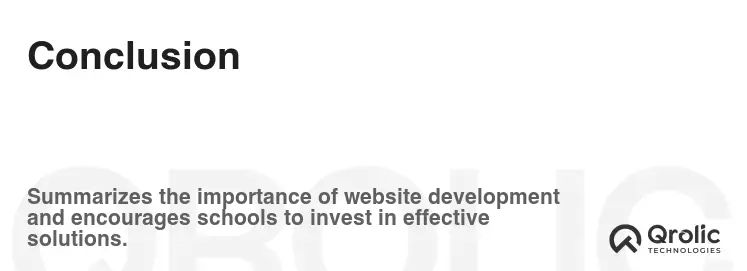
In conclusion, a well-developed website is an indispensable asset for any language school seeking to thrive in today’s competitive landscape. By focusing on user experience, implementing strong SEO strategies, and avoiding common pitfalls, you can create a website that not only attracts new students but also builds trust, streamlines enrollment, and showcases your unique value proposition. Partnering with a professional website development agency like Qrolic Technologies can provide the expertise and support needed to achieve these goals and unlock the full potential of your online presence. Invest in your website, and you’ll be investing in the future success of your language school.
